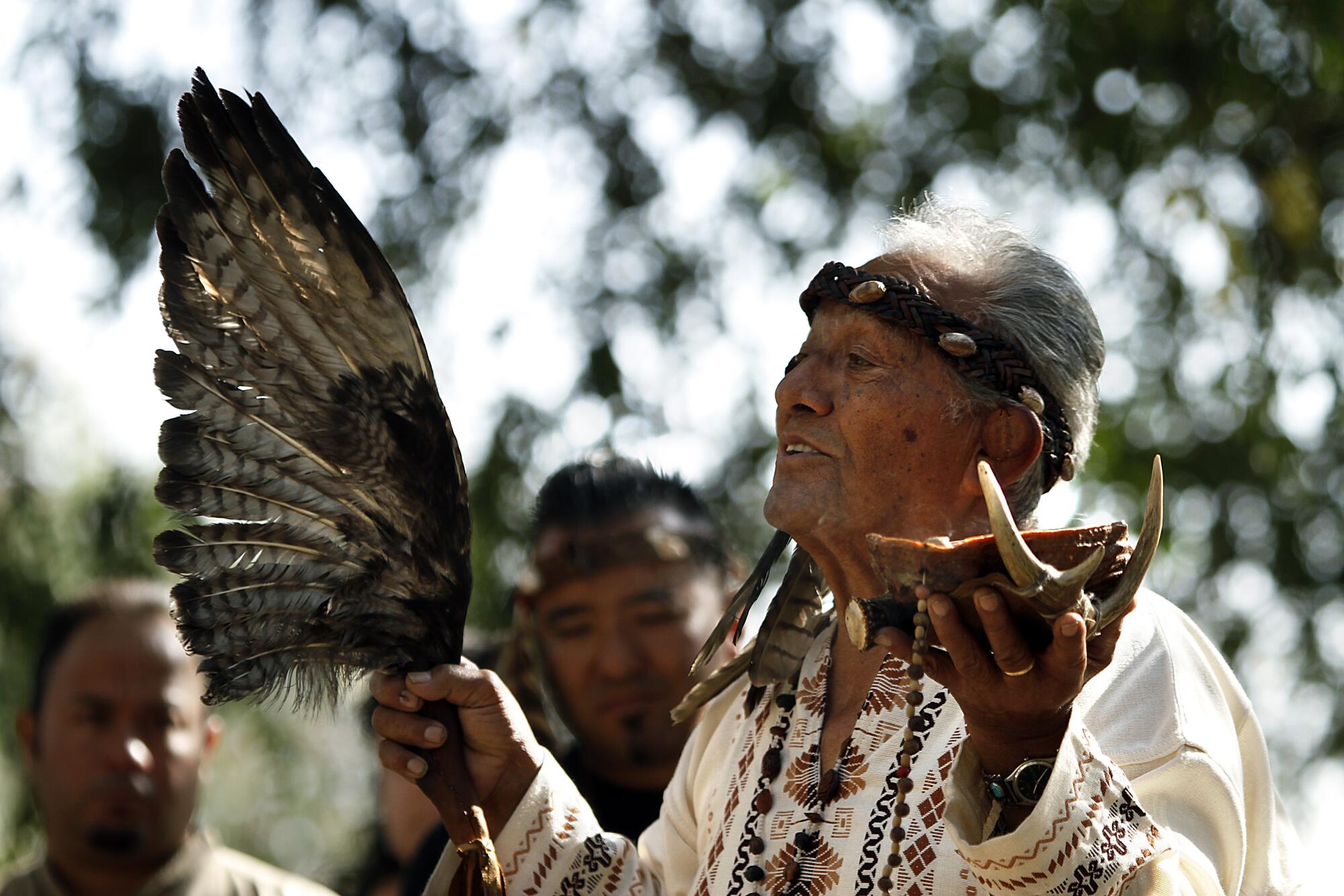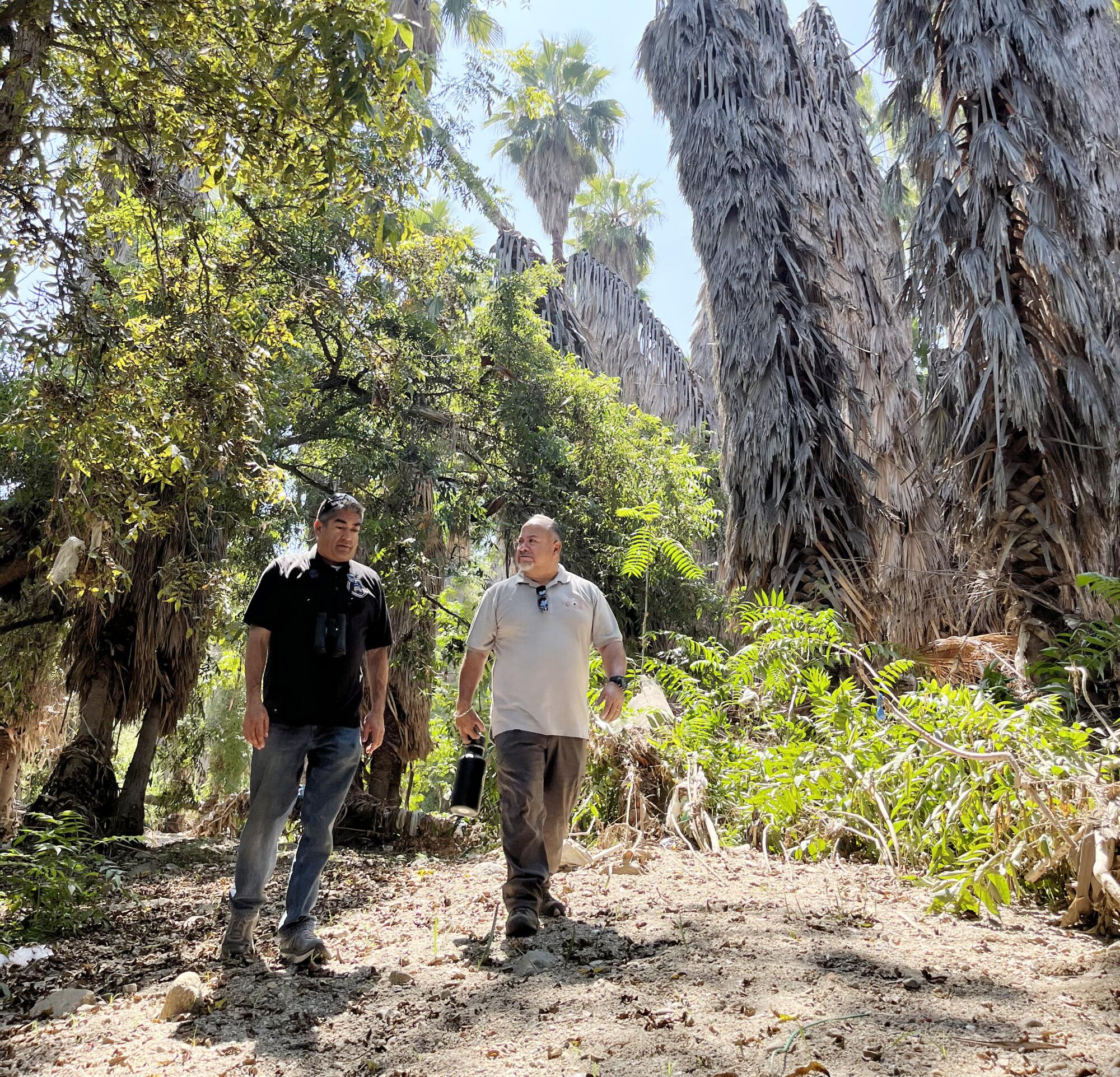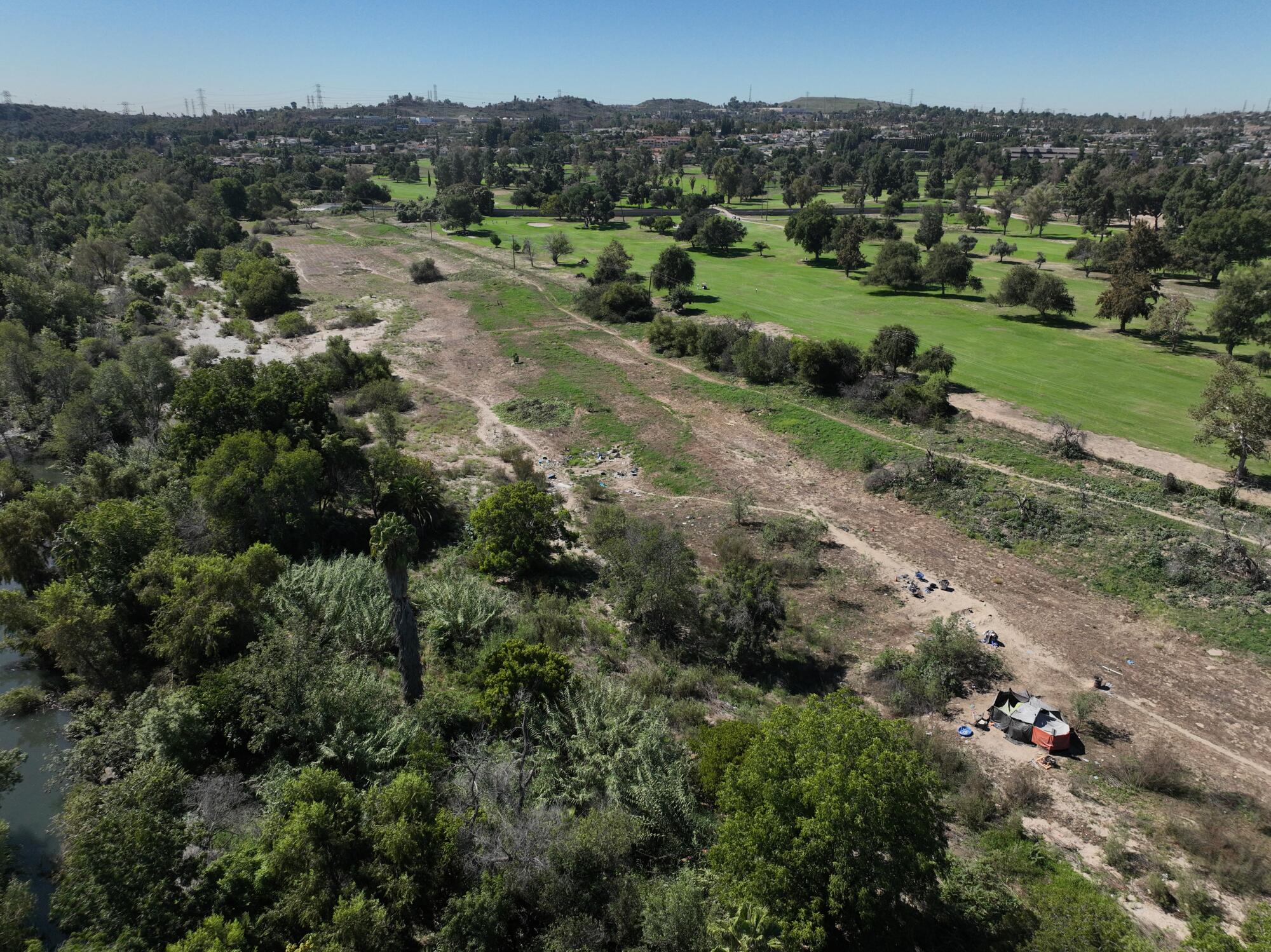For hundreds of thousands of Los Angeles-area motorists, the Whittier Narrows Recreation Space flashes by right away — a tattered oasis of wetlands, sycamore and oak that punctuates the monotonous sprawl of business parks, cinder-block sound partitions and residential cul-de-sacs alongside the 60 Freeway and Rosemead Boulevard.
However to Andrew Salas, chairman of the Gabrieleño-Kizh tribe, this space nonetheless echoes with the voices of his ancestors, who referred to as it Shevaanga.
“What Beverly Hills is to Los Angeles, Shevaanga was to the true first individuals of the Los Angeles Basin,” Salas mentioned.
Few space residents would ever guess that one other tradition thrived right here for 1000’s of years amid a panorama of oak and walnut woodlands riven with waterways teeming with steelhead trout and prowled by wolves and grizzly bears.
However now, Shevaanga is amongst a whole lot of websites drawing new consideration within the “Mapping Los Angeles Panorama Historical past” undertaking.
The trouble seeks as an instance main settlements and the roads that related them — a 2,500-mile community of paths that stretched throughout the Los Angeles Basin and past and had been used to move acorns, walnuts, pine nuts, elderberries, tar for waterproofing plank ships, shells labored into beads, and salt minerals used to protect fish.

Andrew Salas, chairman of the Gabrieleño Band of Mission Indians-Kizh, holds a grinding stone he discovered at Whittier Narrows Recreation Space.
(Louis Sahagun / Los Angeles Instances)
The undertaking is the results of an unlikely partnership of three tribes — Chumash, Tataviam, and Kizh-Gabrieleño — in addition to geographers, historians, biologists, and laptop scientists from USC, UCLA and Cal State’s Northridge, Los Angeles and Lengthy Seaside campuses.
Undergraduate college students from Accelcraft Institute of Geoinformatics and Telangana College, in India, additionally helped to extract the elevations of over 15 million particular person factors situated on historic topographic maps.
“Our purpose is to assist individuals higher perceive the entire of historical past in Los Angeles’ yard,” mentioned Phil Ethington, professor of historical past, political science, and spatial sciences at USC. Certainly, one of many villages, Yaangna, occupied an space that now hosts Union Station, in downtown Los Angeles.
“We present how Los Angeles is rooted in an historical metropolis of buying and selling facilities and seafaring communities ruled by royal households and surrounded by forests and grasslands rigorously managed to enlarge the abundance of pure assets,” he mentioned.
Aggressive and impactful reporting on local weather change, the setting, well being and science.
The three-year undertaking, funded by the John Randolph Haynes and Dora Haynes Basis, investigated six villages that when flourished right here. The trouble relied on oral histories of native tribes, distant sensing gear aboard satellites, U.S. Geological Survey topographic maps, century-old aerial images, historic archives, museum collections and regulation facilities.
“We needed to dig deep for proof of the good society buried underneath our fashionable empire of terraced and graded slopes, rivers sheathed in concrete, industrial growth, freeways and sprawl,” mentioned Travis Longcore, a professor at UCLA’s Institute of the Setting and Sustainability.
“We imagine this undertaking will function a significant useful resource for regional and native planning efforts involving sustainability, restoring habitat with native vegetation, and adapting to local weather change,” he mentioned.
The result’s a novel assortment of extremely detailed three-dimensional digital maps charting prehistoric human interactions with the pure setting at Humaliwo (now Malibu), Siutcanga (Encino), Achoicomenga (San Fernando), Yaangna (Los Angeles), Shevaanga (Whittier Narrows), and Povuu’unga (Lengthy Seaside).
Venture maps additionally evaluate Indigenous roads and pathways with up to date highways, and depict the distribution of crops and timber essential to Indigenous meals methods and chook populations over the centuries.
One map reveals the areas of streams, wetlands, vernal swimming pools and tidal flats that had been buried or drastically altered to accommodate city growth.
When Europeans arrived, nonetheless, they took over tribal lands in addition to the roadways and different vital contributions of the Indigenous founders of the area.
Ventura Boulevard, the 101 Freeway by the San Fernando Valley, and the 110 Freeway between Los Angeles and Lengthy Seaside had been constructed on historical roadways, the researchers mentioned.
For Matt Vestuto, chairman of the Barbareno/Ventureno Band of Mission Indians, the mapping undertaking affords hope for an extended overdue reappraisal of Native American historical past, one which, as he put it, “doesn’t begin out depicting our individuals as California mission slaves.”
Strolling throughout the positioning of a prehistoric seaport at Malibu Lagoon that related mainland tribes with the Channel Islands, Vestuto smiled lately and mentioned, “Our lifeways and economies had been versatile and steady for hundreds of years.
“Virtually in a single day, we had been disenfranchised from the panorama — however our persons are nonetheless right here,” he mentioned. “Now, the problem is to revive the setting, and rebuild our nations.”
Salas, 55, has additionally helped to battle for the reminiscence of his ancestors. He and fellow tribe members regard the Whittier Narrows settlement space with reverence.
In 2010, tribal members led by Salas and his father, religious chief Ernest Perez Salas Teutimez, now deceased, helped defeat a plan to construct a 14,000-square-foot San Gabriel River Discovery Heart and a parking zone for law-enforcement automobiles within the space.
Throughout a blessing ceremony held in a glade of sycamores on the time, Salas’ father mentioned, “That is our final frontier near residence. We need to preserve it simply the best way it’s so that we always remember the teachings hidden underneath each leaf and rock.”

2010 photograph of Ernest Perez Salas Teutimez, the late religious chief of the Gabrieliño Band of Mission Indians, throughout an motion in opposition to the event of the Whittier Narrows Recreation Space.
(Rick Loomis / Los Angeles Instances)
On a latest morning, Salas brushed grime away from a palm-sized rock grinding instrument that he discovered protruding from a sandbank. “It’s a granite ‘mano,’” he mentioned, “used to grind grain and seeds.”
As Salas was telling the story of the mano, Matthew Teutimez, a tribal biologist, was taking inventory of close by native vegetation that supported Indigenous populations for hundreds of years: elderberries, mudwort, jimson weed, spearmint, walnut timber, grape vines, and sage.
“They’re remnants of a time when the lives of our ancestors had been entwined with the realm’s wealthy biodiversity and sacred locations akin to hilltops and caves, the place they talked to the creator,” Teutimez, 47, mentioned.

Matt Teutimiz, left, a tribal biologist for Gabrieleño tribes, and Andrew Salas, chairman of the Gabrieliño Band of Mission Indians-Kizh, observe the pathways of their historical ancestors at Whittier Narrows Recreation Space.
(Louis Sahagun / Los Angeles Instances)
A turning level got here in 1769, with the arrival of Spain’s first colonizing expedition. A commander underneath Spanish navy officer Gaspar de Portolá recounted the initially peaceable assist and steerage supplied by Indigenous peoples.
“The natives got here to just about each place the place our males camped … offered us fish, hare, nuts, pine nuts, acorns, and different seeds ready after their trend,” he wrote. “It was by no means mandatory for us to make use of our weapons for any function aside from to acquire some recreation, which was typically bears.”

An aerial view of the Rio Hondo wash and Whittier Narrows Golf Course within the Whittier Narrows Recreation Space.
(Allen J. Schaben/Los Angeles Instances)
This preliminary amity was very short-lived: The affluent and beneficiant Native American tribes of Southern California had been conquered by Spanish settlers, then enslaved by imperious theologians to launch a mission-building marketing campaign that stretched from San Diego to San Francisco.
After the missions, the tribes got here to be often known as Gabrieleños, a reputation that conjures up the beginning of an period of terror and massacres for Native Individuals who had existed right here since time immemorial.
The California Gold Rush of 1849 impressed a flood of immigrants and federal assist for native Indian-killing campaigns. California’s Native American inhabitants plunged from 150,000 to 30,000 within the mid-1800s, in response to Benjamin Madley, a UCLA historian and creator of “American Genocide: America and the California Indian Disaster, 1846-1873.”
Lower than a century later, Southern California was mushrooming right into a metropolis amid showers of welder’s sparks, clanking jackhammers, lumbering earthmovers, and flashy new cultural and business landmarks rearing skyward.
The Native Californian inhabitants has rebounded to about 150,000, a lot of whom belong to the state’s 110 federally acknowledged tribes. These teams are in a position to decide their very own future, and in lots of instances, that future has concerned profitable playing palaces.
The Gabrieleño tribes, nonetheless, are amongst roughly two dozen unrecognized and landless tribes in California which have initiated petitions for federal recognition by the Division of Inside’s Bureau of Indian Affairs.
The stakes are excessive. A federally acknowledged tribe has sovereignty, doesn’t pay taxes and is exempt from following state or county authorized ordinances. It’s entitled to full service from native regulation enforcement authorities and fireplace departments, hospitals, and street and flood management methods.
It’s also eligible for federal help from authorized packages created to assist reclaim lands misplaced over the many years by tax gross sales, fraud and violence, and with healthcare, schooling and safety of sacred websites.
Few of these petitions are more likely to succeed, consultants say, as a result of they often price a whole lot of 1000’s of {dollars}, require intensive documentation and analysis by anthropologists, historians and tribal members and may take a decade or extra.
However for Salas and Teutimez, Whittier Narrows stays a potent image, geographically and politically, of historic injustice — and a really perfect place for a rebirth of the Gabrieleño Nation.
“We filed our software for federal recognition in 2010,” Salas mentioned. “I really imagine that it’s going to occur in my lifetime.”
Watch L.A. Instances Immediately at 7 p.m. on Spectrum Information 1 on Channel 1 or stay stream on the Spectrum Information App. Palos Verdes Peninsula and Orange County viewers can watch on Cox Programs on channel 99.
#Researchers #map #historical #tribal #villages #Los #Angeles

